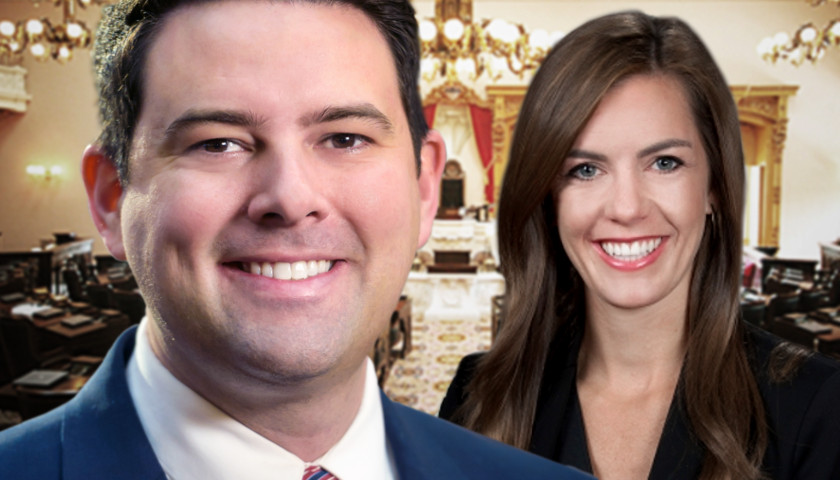As the Ohio Legislature studies ongoing reforms to occupational licensing, some say the move could give the state’s economy a much-needed boost while also reducing recidivism.
The Ohio House State and Local Government Committee on Wednesday plans to study a plan to revise laws regulating barbers and cosmetologists. The agenda for the legislation is available here. The text of House Bill 399 – sponsored by Rep. Jena Powell (R-Arcanum) (pictured above) – is available here.
Previous reporting by The Ohio Star on this topic is available here and here.
To mark the occasion, a conservative think tank has issued a report to encourage more reform.
The Buckeye Institute issued a policy brief, Opening Doors: Occupational Licensing Reform in Ohio After Senate Bill 255 (sponsored by State Sen. Rob McColley (R-Napoleon) pictured above), where it identified 30 licenses that the state can eliminate or where training hours can be reduced, with the potential to save Ohioans potentially thousands of dollars and countless hours of training.
“Too often in Ohio, a seemingly arbitrary system of occupational licensing stands between Ohioans and their chosen careers,” said Andrew J. Kidd, an economist with The Buckeye Institute’s Economic Research Center and a co-author of Opening Doors. “To aid the legislature’s review, The Buckeye Institute examined the same licenses currently being reviewed by the Ohio House, and identified 30 licenses that can be eliminated or reformed. By adopting these changes policymakers will make Ohio a more attractive place to live and start a business.”
The list of licenses the institute identified range from Alternative Principal to Radiologist Assistant.
The upcoming legislative review for barber and cosmetologist licenses is part of an ongoing reform which began in the Ohio General Assembly last year, The Buckeye Institute said in the Opening Doors report.
Under the new law, Senate Bill 255, state licensing boards must justify the burdens they impose on applicants. A sunset provision gives every state board or agency a six-year shelf-life, which requires the Ohio legislature to review and reauthorize every board’s or agency’s existence.
The report continues with an examination of the economic — and human — consequences of such heavy government burdens.
As The Buckeye Institute’s Forbidden to Succeed: How Licensure Laws Hold Ohioans Back explained, high fees and training requirements reduce an occupation’s job growth by 20 percent, as prospective workers who cannot afford to enter the occupation remain unemployed or underemployed. Our subsequent study, Still Forbidden to Succeed: The Negative Effects of Occupational Licensing on Ohio’s Workforce, observed that Ohio’s occupational licensing requirements levy greater burdens on middle-aged and low-income workers, and those without a college degree. Ohio’s licensing requirements have prevented more than 7,000 people between the ages of 25-45 from pursuing licensed occupations, and have discouraged countless people from coming to live and work in Ohio.
One can only imagine the degree of economic stagnation such burdens impose on Ohio’s economy. The report continues with an analysis of the impact on the tax base.
If the ongoing reforms are successful, Ohio’s economy could be the beneficiary. The need is great.
The number of unemployed Ohioans grew 3,000 in October with a jobless rate of 4.2 percent, more than half a percentage point above the national average of 3.6 percent, The Ohio Star reported last month, citing the Ohio Department of Job and Family Services.
The stifling occupational license regulations are part of climate that seems to discourage the creation of jobs.
Despite a high unemployment rate and decrease in jobs, Ohio keeps adding new business entities. The Star recently studied this phenomenon and pointed out that the business filings could simply be a shell game by companies to lower their exposure to the state’s CAT tax, or tax on gross earnings. That report is available here.
The stakes are big, as small businesses like these regulated occupations account for much of the nation’s jobs.
The U.S. Small Business Administration in April released an analysis of small business employment. The 2019 Small Business Profiles report show that small businesses added 1.8 million net new jobs in the United States during the latest year studied. The United States has 30.7 million small businesses, and they employ 47.3 percent of the private workforce.
“The data clearly show small businesses are at the forefront of economic growth,” said Acting Chief Counsel Major L. Clark, III. “Each of our country’s 30.7 million small businesses helps drive job growth and economic development in United States.”
The Buckeye Institute identified another benefit of occupational licensing deregulation.
Daniel J. Dew, legal fellow at the institute’s Legal Center, testified last month to the Ohio House Commerce and Labor Committee on House Bill 263. The bill would reduce occupational licensing restrictions that put road blocks in the way of ex-inmates who are trying to find jobs.
Dew said restrictions “make it harder for ex-offenders to be licensed or hired [which] can cause recidivism rates to rise.”
– – –
Jason M. Reynolds has more than 20 years’ experience as a journalist at outlets of all sizes.





